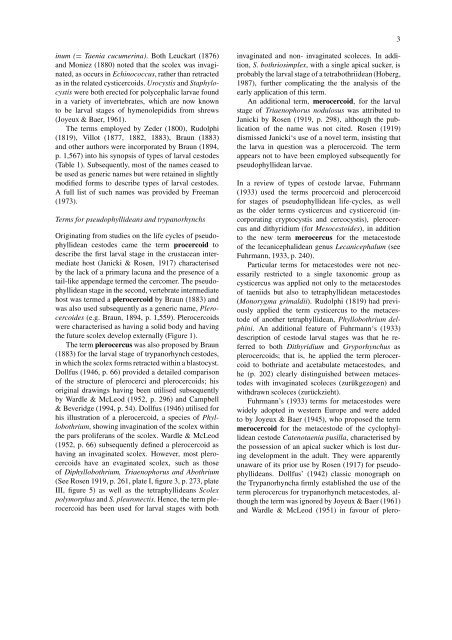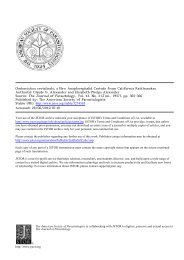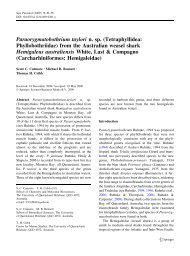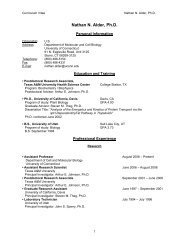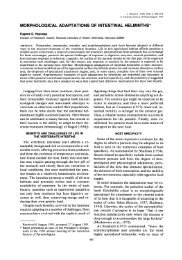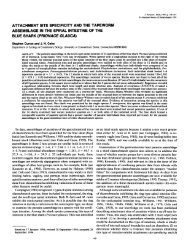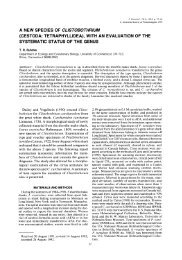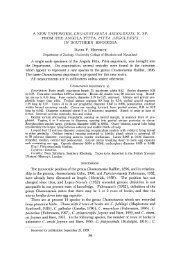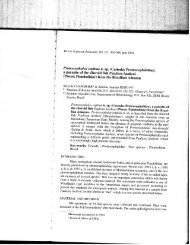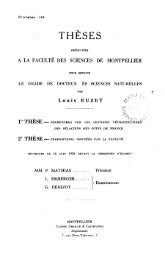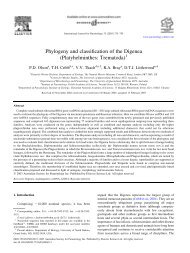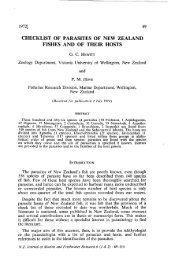The terminology of larval cestodes or metacestodes
The terminology of larval cestodes or metacestodes
The terminology of larval cestodes or metacestodes
You also want an ePaper? Increase the reach of your titles
YUMPU automatically turns print PDFs into web optimized ePapers that Google loves.
3inum (= Taenia cucumerina). Both Leuckart (1876)and Moniez (1880) noted that the scolex was invaginated,as occurs in Echinococcus, rather than retractedas in the related cysticercoids. Urocystis and Staphylocystiswere both erected f<strong>or</strong> polycephalic larvae foundin a variety <strong>of</strong> invertebrates, which are now knownto be <strong>larval</strong> stages <strong>of</strong> hymenolepidids from shrews(Joyeux & Baer, 1961).<strong>The</strong> terms employed by Zeder (1800), Rudolphi(1819), Villot (1877, 1882, 1883), Braun (1883)and other auth<strong>or</strong>s were inc<strong>or</strong>p<strong>or</strong>ated by Braun (1894,p. 1,567) into his synopsis <strong>of</strong> types <strong>of</strong> <strong>larval</strong> <strong>cestodes</strong>(Table 1). Subsequently, most <strong>of</strong> the names ceased tobe used as generic names but were retained in slightlymodified f<strong>or</strong>ms to describe types <strong>of</strong> <strong>larval</strong> <strong>cestodes</strong>.A full list <strong>of</strong> such names was provided by Freeman(1973).Terms f<strong>or</strong> pseudophyllideans and trypan<strong>or</strong>hynchsOriginating from studies on the life cycles <strong>of</strong> pseudophyllidean<strong>cestodes</strong> came the term procercoid todescribe the first <strong>larval</strong> stage in the crustacean intermediatehost (Janicki & Rosen, 1917) characterisedby the lack <strong>of</strong> a primary lacuna and the presence <strong>of</strong> atail-like appendage termed the cercomer. <strong>The</strong> pseudophyllideanstage in the second, vertebrate intermediatehost was termed a plerocercoid by Braun (1883) andwas also used subsequently as a generic name, Plerocercoides(e.g. Braun, 1894, p. 1,559). Plerocercoidswere characterised as having a solid body and havingthe future scolex develop externally (Figure 1).<strong>The</strong> term plerocercus was also proposed by Braun(1883) f<strong>or</strong> the <strong>larval</strong> stage <strong>of</strong> trypan<strong>or</strong>hynch <strong>cestodes</strong>,in which the scolex f<strong>or</strong>ms retracted within a blastocyst.Dollfus (1946, p. 66) provided a detailed comparison<strong>of</strong> the structure <strong>of</strong> plerocerci and plerocercoids; his<strong>or</strong>iginal drawings having been utilised subsequentlyby Wardle & McLeod (1952, p. 296) and Campbell& Beveridge (1994, p. 54). Dollfus (1946) utilised f<strong>or</strong>his illustration <strong>of</strong> a plerocercoid, a species <strong>of</strong> Phyllobothrium,showing invagination <strong>of</strong> the scolex withinthe pars proliferans <strong>of</strong> the scolex. Wardle & McLeod(1952, p. 66) subsequently defined a plerocercoid ashaving an invaginated scolex. However, most plerocercoidshave an evaginated scolex, such as those<strong>of</strong> Diphyllobothrium, Triaenoph<strong>or</strong>us and Abothrium(See Rosen 1919, p. 261, plate I, figure 3, p. 273, plateIII, figure 5) as well as the tetraphyllideans Scolexpolym<strong>or</strong>phus and S. pleuronectis. Hence, the term plerocercoidhas been used f<strong>or</strong> <strong>larval</strong> stages with bothinvaginated and non- invaginated scoleces. In addition,S. bothriosimplex, with a single apical sucker, isprobably the <strong>larval</strong> stage <strong>of</strong> a tetrabothriidean (Hoberg,1987), further complicating the the analysis <strong>of</strong> theearly application <strong>of</strong> this term.An additional term, merocercoid, f<strong>or</strong> the <strong>larval</strong>stage <strong>of</strong> Triaenoph<strong>or</strong>us nodulosus was attributed toJanicki by Rosen (1919, p. 298), although the publication<strong>of</strong> the name was not cited. Rosen (1919)dismissed Janicki‘s use <strong>of</strong> a novel term, insisting thatthe larva in question was a plerocercoid. <strong>The</strong> termappears not to have been employed subsequently f<strong>or</strong>pseudophyllidean larvae.In a review <strong>of</strong> types <strong>of</strong> cestode larvae, Fuhrmann(1933) used the terms procercoid and plerocercoidf<strong>or</strong> stages <strong>of</strong> pseudophyllidean life-cycles, as wellas the older terms cysticercus and cysticercoid (inc<strong>or</strong>p<strong>or</strong>atingcryptocystis and cercocystis), plerocercusand dithyridium (f<strong>or</strong> Mesocestoides), in additionto the new term merocercus f<strong>or</strong> the metacestode<strong>of</strong> the lecanicephalidean genus Lecanicephalum (seeFuhrmann, 1933, p. 240).Particular terms f<strong>or</strong> meta<strong>cestodes</strong> were not necessarilyrestricted to a single taxonomic group ascysticercus was applied not only to the meta<strong>cestodes</strong><strong>of</strong> taeniids but also to tetraphyllidean meta<strong>cestodes</strong>(Mon<strong>or</strong>ygma grimaldii). Rudolphi (1819) had previouslyapplied the term cysticercus to the metacestode<strong>of</strong> another tetraphyllidean, Phyllobothrium delphini.An additional feature <strong>of</strong> Fuhrmann‘s (1933)description <strong>of</strong> cestode <strong>larval</strong> stages was that he referredto both Dithyridium and Gryp<strong>or</strong>hynchus asplerocercoids; that is, he applied the term plerocercoidto bothriate and acetabulate meta<strong>cestodes</strong>, andhe (p. 202) clearly distinguished between meta<strong>cestodes</strong>with invaginated scoleces (zurükgezogen) andwithdrawn scoleces (zurückzieht).Fuhrmann’s (1933) terms f<strong>or</strong> meta<strong>cestodes</strong> werewidely adopted in western Europe and were addedto by Joyeux & Baer (1945), who proposed the termmerocercoid f<strong>or</strong> the metacestode <strong>of</strong> the cyclophyllideancestode Catenotaenia pusilla, characterised bythe possession <strong>of</strong> an apical sucker which is lost duringdevelopment in the adult. <strong>The</strong>y were apparentlyunaware <strong>of</strong> its pri<strong>or</strong> use by Rosen (1917) f<strong>or</strong> pseudophyllideans.Dollfus’ (1942) classic monograph onthe Trypan<strong>or</strong>hyncha firmly established the use <strong>of</strong> theterm plerocercus f<strong>or</strong> trypan<strong>or</strong>hynch meta<strong>cestodes</strong>, althoughthe term was ign<strong>or</strong>ed by Joyeux & Baer (1961)and Wardle & McLeod (1951) in favour <strong>of</strong> plero-


